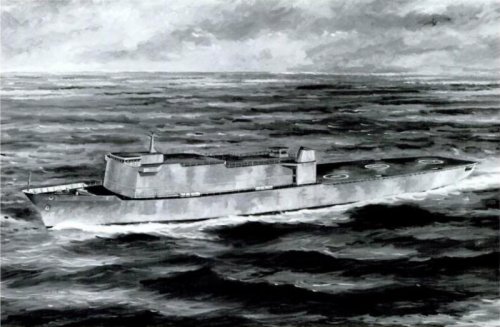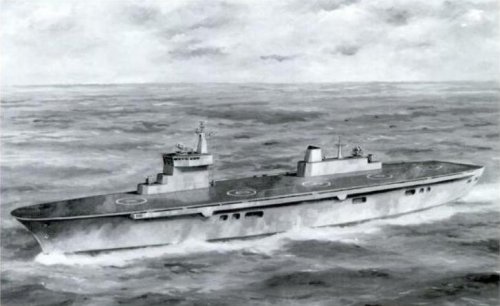About 1980, there was a considerable number of design studies into ships that combined the role of replenishment and helicopter carrier in different proportions to create a "cheap" carrier. The simplest variants had a box hanger forward and a big deck with three landing spots aft. This arrangement is only suitable for an aircraft complement of up to six, above which movement in the hanger becomes difficult. A similar conclusions were reached in early studies leading to the Invincible-class.
If more numerous aircraft are needed a conventional through-deck carrier configuration with an island superstructure and flight deck with about five spots and below deck hanger is required. Two elevators are essential since one may be disabled by accident or damage. This configuration would make an alternative deck for V/STOL aircraft to land, refuel, and some limited re-arming. It could not have full maintenance facilities without escalating to the size and cost of a small aircraft carrier (CVS).
There was prolonged discussion about whether these ships should be Royal Navy (RN) or Royal Fleet Auxiliary (RFA) manned. If RFA manned, larger and more attractive living quarters would be required and the RFA insisted that the ships be powered by commercial diesels. If RN manned, the RN was equally insistent that they be powered by gas turbines. Originally the RN manning would have had a ship CO of Commander rank, but when it was decided that the air group needed a Captain the ship CO became a Captain rank.
One major problem applied to both configurations is that flight deck operations made it impossible to have any replenishment rigs on the port side and probably no more than two to starboard. In the "carrier" configuration, the hanger deck must be high enough to prevent flooding after damage--increasing the size and cost of the ship.
Artist's impression of replenishment ship helicopter carrier with a hanger forward and "through deck" carrier configuration.
Source: Rebuilding the Royal Navy: Warship Design Since 1945 by DK Brown and George Moore
If more numerous aircraft are needed a conventional through-deck carrier configuration with an island superstructure and flight deck with about five spots and below deck hanger is required. Two elevators are essential since one may be disabled by accident or damage. This configuration would make an alternative deck for V/STOL aircraft to land, refuel, and some limited re-arming. It could not have full maintenance facilities without escalating to the size and cost of a small aircraft carrier (CVS).
There was prolonged discussion about whether these ships should be Royal Navy (RN) or Royal Fleet Auxiliary (RFA) manned. If RFA manned, larger and more attractive living quarters would be required and the RFA insisted that the ships be powered by commercial diesels. If RN manned, the RN was equally insistent that they be powered by gas turbines. Originally the RN manning would have had a ship CO of Commander rank, but when it was decided that the air group needed a Captain the ship CO became a Captain rank.
One major problem applied to both configurations is that flight deck operations made it impossible to have any replenishment rigs on the port side and probably no more than two to starboard. In the "carrier" configuration, the hanger deck must be high enough to prevent flooding after damage--increasing the size and cost of the ship.
Artist's impression of replenishment ship helicopter carrier with a hanger forward and "through deck" carrier configuration.
Source: Rebuilding the Royal Navy: Warship Design Since 1945 by DK Brown and George Moore


